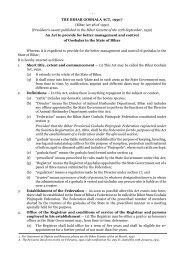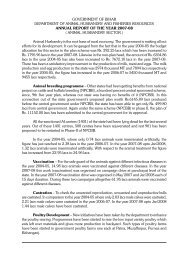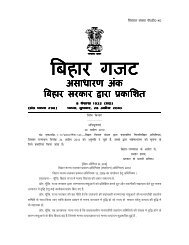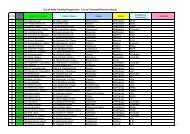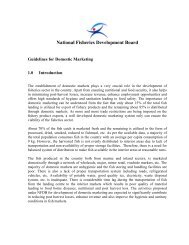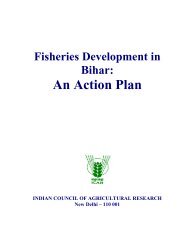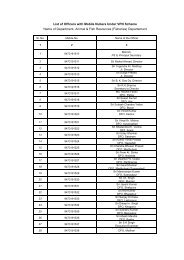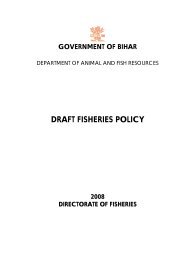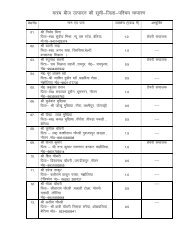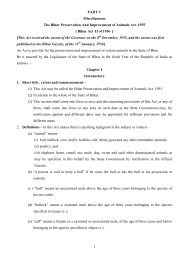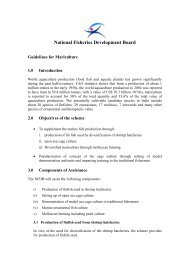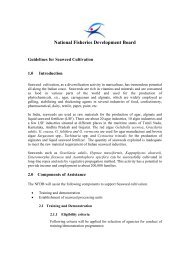National Fisheries Development Board - Animal & Fish Resources
National Fisheries Development Board - Animal & Fish Resources
National Fisheries Development Board - Animal & Fish Resources
You also want an ePaper? Increase the reach of your titles
YUMPU automatically turns print PDFs into web optimized ePapers that Google loves.
The Central Institute of <strong><strong>Fish</strong>eries</strong> Nautical Engineering and Training (CIFNET), Kochiconducts an 18 month Mate <strong>Fish</strong>ing Vessel Course (MFVC). The trainees after completing thiscourse are required to undergo 24 months sea service, which can be completed in either aGovernment fishing vessel (e.g. those of FSI) or a private-owned fishing vessel. These traineescan also form an ideal pool of candidates who could be trained in tuna fishing and some ofthem may later also serve as trainers.The <strong>Board</strong> may cooperate with the CIFNET and the Association of <strong>Fish</strong>ing Industries (AFI),Visakhapatnam to prepare the training calendar and curriculum. The premises of CIFNET andthe FSI on both the east (Visakhapatnam, Chennai) and west coasts (Cochin, Goa, Porbandar))could be used for training and the CIFNET and the AFI may coordinate the trainingprogramme on behalf of the NFDB. The agencies assisting NFDB in this regard could bereimbursed the cost that would be incurred for coordination, etc. The other trainees could besponsored by the industry on a regular basis.3.3 <strong>Development</strong> of shore-based infrastructureMaintenance of adequate levels of hygiene and sanitation at all stages of harvesting and postharvestis of utmost importance if tuna is to be marketed in sashimi grade. In this regard themaintenance of fishing harbours/ fish landing centers (FLCs) becomes critical and cannot beoverlooked. Presently, the fishing harbours at Visakhapatnam, Chennai, Cochin and Mumbaihandle the bulk of tuna landings. It is, therefore, essential that these harbours and also thosewhere tuna landings might increase substantially in the near future (e.g. Goa, Pondicherry,Vanakbara, etc) should be renovated to ensure that that have the optimum levels of hygieneand sanitation and all other facilities that is required for quick handling of the catch before it iseither sent to the processing unit or packed for export. If possible, the provision of dedicatedjetties for tuna landings could also be considered in these harbours to minimize the risks ofcontamination and facilitate quick handling.The NFDB may collaborate with the Central Institute of Coastal Engineering for <strong>Fish</strong>ery(CICEF), Bangaluru and the AFI, Visakhapatnam for preparing a master plan for up-gradationof fishing harbours and FLCs, which are important from the tuna fisheries point of view.3.4 Upgradation of processing unitsThe most common forms in which tuna and tuna-like species are exported include thepremium-grade sashimi tuna, followed by steaks and loins and finally canned tuna. Sashimi isprepared from fresh, high quality raw tuna meat, or from tuna frozen at temperatures below –40ºC immediately after capture. Traditional sashimi is prepared from the three species ofbluefin, bigeye and yellow fin tunas. Tunas that are not acceptable for sashimi grade are soldin the steak market, generally in Europe and the United States. Steaks are generally preparedfrom bigeye, yellowfin and albacore tunas, mostly fresh but also frozen.Japan is the world’s largest producer and market for fresh and frozen tuna and tuna basedproducts (excluding canned tuna). In recent years, tuna in the form of sashimi and steaks isbecoming increasingly common within the European and North American markets (and nowalso in China). The major importers of canned tuna are the United States, the United Kingdomand France, in terms of both quantity and value. Skipjack, yellowfin and albacore are the



